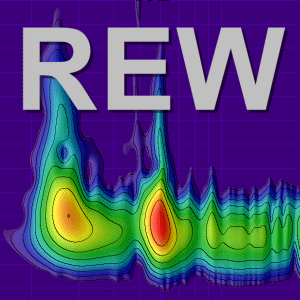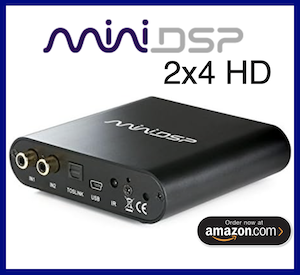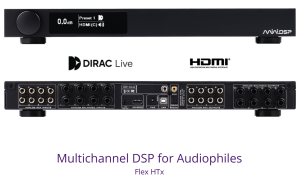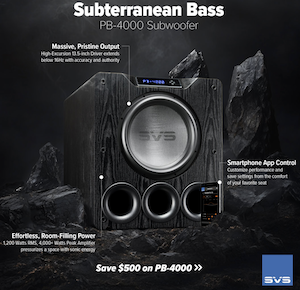-
AUDIO VIDEO PROCESSING, SETUP & ENVIRONMENTOfficial REW (Room EQ Wizard) Support Forum Audiolense User Forum Calibration Equipment Auto-EQ Platforms / Immersive Audio Codecs Video Display Technologies / Calibration AV System Setup and Support Listening Room / Home Theater Build Projects Room Acoustics and Treatments AV Showcase Movies / Music / TV / Streaming
-
AUDIO VIDEO DISCUSSION / EQUIPMENTHome Theater / Audio and Video - Misc Topics Essence For Hi Res Audio AV Equipment Advice and Pricing Awesome Deals and Budget AV Equipment AV Receivers / Processors / Amps UHD / Blu-ray / CD Players / Streaming Devices Two Channel Hi-Fi Equipment DIY Audio Projects Computer Systems - HTPC / Gaming HD and UHD Flat Screen Displays Projectors and Projection Screens AV Accessories Buy - Sell - Trade
Navigation
Install the app
How to install the app on iOS
Follow along with the video below to see how to install our site as a web app on your home screen.
Note: This feature may not be available in some browsers.
More options
You are using an out of date browser. It may not display this or other websites correctly.
You should upgrade or use an alternative browser.
You should upgrade or use an alternative browser.
Time alignment vs Phase alignment?
- Thread starter Harrycr
- Start date
jtalden
Senior Member
More
- Preamp, Processor or Receiver
- Marantz AV7705 Pre/Pro
- Main Amp
- VTV 6 chnl NC252MP P-amp x 2
- Additional Amp
- Behringer DCX2496 x 2
- Universal / Blu-ray / CD Player
- OPPO BDP-103 Universal Player
- Front Speakers
- DIY SEAS H1456/H1212 Spkr x 5
- Subwoofers
- DIY JBL 2235H 15" SW x 2
- Screen
- Da-Lite Da-Snap 39105V - 92"
- Video Display Device
- JVC DLA-X790R
It is hard to know the exact intent when these terms are used. They are often used interchangeably with respect to crossover timing. There are often 2 or 3 favorable alignments at the listening position and one could contend that each of these are time and phase aligned.
A conventional crossover target alignment is the one that provides the closest phase tracking for the direct sound throughout the crossover range. It is both time and phase aligned. In the case of SW crossover timing, room effects often make this target unfavorable for SPL response at the listening position and thus we adjust the timing as needed for SPL favorability.
A conventional crossover target alignment is the one that provides the closest phase tracking for the direct sound throughout the crossover range. It is both time and phase aligned. In the case of SW crossover timing, room effects often make this target unfavorable for SPL response at the listening position and thus we adjust the timing as needed for SPL favorability.
It is hard to know the exact intent when these terms are used. They are often used interchangeably with respect to crossover timing. There are often 2 or 3 favorable alignments at the listening position and one could contend that each of these are time and phase aligned.
A conventional crossover target alignment is the one that provides the closest phase tracking for the direct sound throughout the crossover range. It is both time and phase aligned. In the case of SW crossover timing, room effects often make this target unfavorable for SPL response at the listening position and thus we adjust the timing as needed for SPL favorability.
Thanks
So accurate time alignment should have good phase?
Time align first and then check phase tracking to fine tune?
I suggest you use the spectrogram on Wavelet mode at lower freq resolution numbers (=higher time resolution) to see where the spectrum peak is in time and then adjust the ref time to match that to zero seconds (you may not be able to reach perfectly zero results). Then the phase will be pretty accurate. I have done this when measuring woofer and tweeter separately so that I can tune the crossover for equal acoustic distances.
jtalden
Senior Member
More
- Preamp, Processor or Receiver
- Marantz AV7705 Pre/Pro
- Main Amp
- VTV 6 chnl NC252MP P-amp x 2
- Additional Amp
- Behringer DCX2496 x 2
- Universal / Blu-ray / CD Player
- OPPO BDP-103 Universal Player
- Front Speakers
- DIY SEAS H1456/H1212 Spkr x 5
- Subwoofers
- DIY JBL 2235H 15" SW x 2
- Screen
- Da-Lite Da-Snap 39105V - 92"
- Video Display Device
- JVC DLA-X790R
Yes but I wince a little at the word 'accurate'.So accurate time alignment should have good phase?
Smooth SPL is demonstrably the most important characteristic of good bass response. Good phase tracking is required in order to provide generally good SPL support across the XO range that can be more effectively EQ'ed.
Yes, that is my approach. I time align to the direct sound and then adjust timing as needed for favorable SPL at the LP position.Time align first and then check phase tracking to fine tune?
See here If interested, run the exercises to get an understanding of the process and then apply it to your situation.
There are all sorts of other DIY methods and numerous automated methods that lead to favorable results. Good SPL support being the main indicator. It is not necessary to use this method. Arguably, the only advantage to this method is that we can more easily find the direct sound timing. We can then understand why and how far we chose to deviated from that initial setting to provide the most favorable SPL result at the LP.
I suggest you use the spectrogram on Wavelet mode at lower freq resolution numbers (=higher time resolution) to see where the spectrum peak is in time and then adjust the ref time to match that to zero seconds (you may not be able to reach perfectly zero results). Then the phase will be pretty accurate. I have done this when measuring woofer and tweeter separately so that I can tune the crossover for equal acoustic distances.
Ok thanks, so same principle.
Did you measure at the MLP?
Thanks.Yes but I wince a little at the word 'accurate'.
Smooth SPL is demonstrably the most important characteristic of good bass response. Good phase tracking is required in order to provide generally good SPL support across the XO range that can be more effectively EQ'ed.
Yes, that is my approach. I time align to the direct sound and then adjust timing as needed for favorable SPL at the LP position.
See here If interested, run the exercises to get an understanding of the process and then apply it to your situation.
There are all sorts of other DIY methods and numerous automated methods that lead to favorable results. Good SPL support being the main indicator. It is not necessary to use this method. Arguably, the only advantage to this method is that we can more easily find the direct sound timing. We can then understand why and how far we chose to deviated from that initial setting to provide the most favorable SPL result at the LP.
There is no "absolute" timing.
Ok so it's the "smoothest" Spl through the xover not the "most" Spl.
I will try the sample once I am able to download the latest update. Only downloads the REW icon (0 bytes) not the actual program.
On the subs (Velodyne DD) they have polarity as well as phase variable 0-180. Why both because isn't polarity basically 0 or 180 phase?
Last edited:
jtalden
Senior Member
More
- Preamp, Processor or Receiver
- Marantz AV7705 Pre/Pro
- Main Amp
- VTV 6 chnl NC252MP P-amp x 2
- Additional Amp
- Behringer DCX2496 x 2
- Universal / Blu-ray / CD Player
- OPPO BDP-103 Universal Player
- Front Speakers
- DIY SEAS H1456/H1212 Spkr x 5
- Subwoofers
- DIY JBL 2235H 15" SW x 2
- Screen
- Da-Lite Da-Snap 39105V - 92"
- Video Display Device
- JVC DLA-X790R
For the final timing adjustment at the LP I typically choose the maximum SPL support across the XO range. Any setting with good SPL support is favorable however.There is no "absolute" timing.
Ok so it's the "smoothest" Spl through the xover not the "most" Spl.
I don't know for sure. I don't have a typical active SW to experiment with. The limited measurement data I have seen here suggests that the phase control operates differently, but there is little if any practical difference between using those 2 settings and arrive at similar SPL support. The phase control does provide another useful method to time/phase align the XO. It is also much easier to do for those that want to get up and running.On the subs (Velodyne DD) they have polarity as well as phase variable 0-180. Why both because isn't polarity basically 0 or 180 phase?
For the final timing adjustment at the LP I typically choose the maximum SPL support across the XO range. Any setting with good SPL support is favorable however.
I don't know for sure. I don't have a typical active SW to experiment with. The limited measurement data I have seen here suggests that the phase control operates differently, but there is little if any practical difference between using those 2 settings and arrive at similar SPL support. The phase control does provide another useful method to time/phase align the XO. It is also much easier to do for those that want to get up and running.
Thanks appreciated.
Right so with a normal xover of say 80hz how far do you typically go either side of 80hz for max spl?
jtalden
Senior Member
More
- Preamp, Processor or Receiver
- Marantz AV7705 Pre/Pro
- Main Amp
- VTV 6 chnl NC252MP P-amp x 2
- Additional Amp
- Behringer DCX2496 x 2
- Universal / Blu-ray / CD Player
- OPPO BDP-103 Universal Player
- Front Speakers
- DIY SEAS H1456/H1212 Spkr x 5
- Subwoofers
- DIY JBL 2235H 15" SW x 2
- Screen
- Da-Lite Da-Snap 39105V - 92"
- Video Display Device
- JVC DLA-X790R
The minimum amount needed to get strong SPL support in hte XO range.
Right maybe 10hz either side?
Is it best to measure Left and right main seperate and the sub seperate with all xovers (eg. xover 80hz receiver, sub xover inactive) active?
Is there any need to measure left and right combined?
With automated Audyssey, YPAO etc. they say keep phase/polarity switch to 0° pre process. How can that work when maybe preferable might be 180°?
Is it best to measure Left and right main seperate and the sub seperate with all xovers (eg. xover 80hz receiver, sub xover inactive) active?
Is there any need to measure left and right combined?
With automated Audyssey, YPAO etc. they say keep phase/polarity switch to 0° pre process. How can that work when maybe preferable might be 180°?
Last edited:
jtalden
Senior Member
More
- Preamp, Processor or Receiver
- Marantz AV7705 Pre/Pro
- Main Amp
- VTV 6 chnl NC252MP P-amp x 2
- Additional Amp
- Behringer DCX2496 x 2
- Universal / Blu-ray / CD Player
- OPPO BDP-103 Universal Player
- Front Speakers
- DIY SEAS H1456/H1212 Spkr x 5
- Subwoofers
- DIY JBL 2235H 15" SW x 2
- Screen
- Da-Lite Da-Snap 39105V - 92"
- Video Display Device
- JVC DLA-X790R
Hz?? No, we change the ms delay or the AVR distance not the XO frequency.Right maybe 10hz either side?
Yes, but we could measure FL+FR instead of measuring them separately. We would just not be able to analyze the impact on the channels separately within REW. We could instead make the change and measure FL+SW and FR+SW to see the effect on the individual channels.Is it best to measure Left and right main seperate and the sub seperate with all xovers (eg. xover 80hz receiver, sub xover inactive) active?
They are combined within REW in the method suggested in the other thread. There are lots of other methods that work just fine.Is there any need to measure left and right combined?
They adjust the timing by distance changes in the AVR. It can work just fine.With automated Audyssey, YPAO etc. they say keep phase/polarity switch to 0° pre process. How can that work when maybe preferable might be 180°?
jtalden
Senior Member
More
- Preamp, Processor or Receiver
- Marantz AV7705 Pre/Pro
- Main Amp
- VTV 6 chnl NC252MP P-amp x 2
- Additional Amp
- Behringer DCX2496 x 2
- Universal / Blu-ray / CD Player
- OPPO BDP-103 Universal Player
- Front Speakers
- DIY SEAS H1456/H1212 Spkr x 5
- Subwoofers
- DIY JBL 2235H 15" SW x 2
- Screen
- Da-Lite Da-Snap 39105V - 92"
- Video Display Device
- JVC DLA-X790R
We are really only trying to get good SPL support in the XO range in the listening area. It's easy to get too distracted in thinking of timing/phase as a quality factor. Those are optional measurement factors that can be used to achieve a favorable SPL. We can all agree that poor timing/phase causes a large SPL dip in the XO range that can be a noticeable sound quality problem. We can easily differ however on how carefully we need to adjust the timing/phase to obtain favorable SPL support. Interestingly, we can also differ on which one of the 2 or 3 favorable SPL solutions sounds the best for any given setup. Most listeners seem to be able to hear a clear difference.
The REW alignment tool method helps those that are interested in inspecting what is happening in the XO range in more detail in and deciding what adjustments are likely to be helpful. It also is the most reliable way to confirm which of 2 or 3 favorable SPL solutions is nearest to the conventional direct sound target alignment. It is not discounting any of the other setup methods available.
The REW alignment tool method helps those that are interested in inspecting what is happening in the XO range in more detail in and deciding what adjustments are likely to be helpful. It also is the most reliable way to confirm which of 2 or 3 favorable SPL solutions is nearest to the conventional direct sound target alignment. It is not discounting any of the other setup methods available.
Hz?? No, we change the ms delay or the AVR distance not the XO frequency.
Yes, but we could measure FL+FR instead of measuring them separately. We would just not be able to analyze the impact on the channels separately within REW. We could instead make the change and measure FL+SW and FR+SW to see the effect on the individual channels.
They are combined within REW in the method suggested in the other thread. There are lots of other methods that work just fine.
They adjust the timing by distance changes in the AVR. It can work just fine.
Sorry the hz either side I meant for example 80hz xover, we should look at best spl through the 60-100hz region?
With AVRs they sometimes suggest to leave the phase/polarity set to 0° degrees and suggest a unusual figure for the delay/distance. Is this because of the phase has done a full cycle, or have I got it all wrong?
Is it best to time align the rear surrounds with the sub, and if so shouldn't the mic be at 90° position?
Thank you
jtalden
Senior Member
More
- Preamp, Processor or Receiver
- Marantz AV7705 Pre/Pro
- Main Amp
- VTV 6 chnl NC252MP P-amp x 2
- Additional Amp
- Behringer DCX2496 x 2
- Universal / Blu-ray / CD Player
- OPPO BDP-103 Universal Player
- Front Speakers
- DIY SEAS H1456/H1212 Spkr x 5
- Subwoofers
- DIY JBL 2235H 15" SW x 2
- Screen
- Da-Lite Da-Snap 39105V - 92"
- Video Display Device
- JVC DLA-X790R
Yes but my rule of thumb would be ±1 octave (40-160 Hz). The measured XO range should be confirmed See here.we should look at best spl through the 60-100hz region?
By 'unusual distance' I assume you mean one that does not match well with the physical measured distance. Yes, that may the reason as there is normally favorable SPL timing that falls roughly at 1/2, 1, etc., wavelength distances from the conventional target timing. If the SPL support is strong that is a favorable setting. If there is a large dip it may, or may not be a good setting. It may just be room effects that cannot be corrected via timing.With AVRs they sometimes suggest to leave the phase/polarity set to 0° degrees and suggest a unusual figure for the delay/distance. Is this because of the phase has done a full cycle,
The mic orientation doesn't matter in the bass range. It only starts to make a difference above about 2 kHz.Is it best to time align the rear surrounds with the sub, and if so shouldn't the mic be at 90°
Surround speakers can reasonably be timed to the SW. I have no strong opinion and have never seen an authoritative discussion/recommendation based on the various sound modes we may decide to use.
Yes but my rule of thumb would be ±1 octave (40-160 Hz). The measured XO range should be confirmed See here.
By 'unusual distance' I assume you mean one that does not match well with the physical measured distance. Yes, that may the reason as there is normally favorable SPL timing that falls roughly at 1/2, 1, etc., wavelength distances from the conventional target timing. If the SPL support is strong that is a favorable setting. If there is a large dip it may, or may not be a good setting. It may just be room effects that cannot be corrected via timing.
The mic orientation doesn't matter in the bass range. It only starts to make a difference above about 2 kHz.
Surround speakers can reasonably be timed to the SW. I have no strong opinion and have never seen an authoritative discussion/recommendation based on the various sound modes we may decide to use.
Thank you
What determines which speaker or sub the delay value is applied too?
In theory shouldn't the value be altered in the mains, because the mains sound is going to be faster than subwoofer sound?
What measurements are required for a dual mono subwoofer and mains time alignment?
With the single sub 80hz xover it is:
Left main only (with receiver 80hz xover set)
Right main only (with receiver 80hz xover set)
Sub only (with sub xover disabled, controlled by the receiver 80hz )
What I do is for the sub I turn off speaker A on the receiver that leaves the sub playing on its own, with only the receiver xover frequency in my case <80hz.
jtalden
Senior Member
More
- Preamp, Processor or Receiver
- Marantz AV7705 Pre/Pro
- Main Amp
- VTV 6 chnl NC252MP P-amp x 2
- Additional Amp
- Behringer DCX2496 x 2
- Universal / Blu-ray / CD Player
- OPPO BDP-103 Universal Player
- Front Speakers
- DIY SEAS H1456/H1212 Spkr x 5
- Subwoofers
- DIY JBL 2235H 15" SW x 2
- Screen
- Da-Lite Da-Snap 39105V - 92"
- Video Display Device
- JVC DLA-X790R
It's the relative timing that is important. Adjust the one(s) that fits the setup situation.What determines which speaker or sub the delay value is applied too?
It makes no difference. The speed of sound is similar for all frequencies.In theory shouldn't the value be altered in the mains, because the mains sound is going to be faster than subwoofer sound?
That works for the the method being discussed here.What measurements are required for a dual mono subwoofer and mains time alignment?
With the single sub 80hz xover it is:
Left main only (with receiver 80hz xover set)
Right main only (with receiver 80hz xover set)
Sub only (with sub xover disabled, controlled by the receiver 80hz )
What I do is for the sub I turn off speaker A on the receiver that leaves the sub playing on its own, with only the receiver xover frequency in my case <80hz.
Popular tags
20th century fox
4k blu-ray
4k uhd
4k ultrahd
action
adventure
animated
animation
bass
blu-ray
calibration
comedy
comics
denon
dirac
dirac live
disney
dolby atmos
drama
fantasy
hdmi 2.1
home theater
horror
kaleidescape
klipsch
lionsgate
marantz
movies
onkyo
paramount
pioneer
rew
romance
sci-fi
scream factory
shout factory
sony
stormaudio
subwoofer
svs
terror
thriller
uhd
ultrahd
ultrahd 4k
universal
value electronics
warner
warner brothers
well go usa












